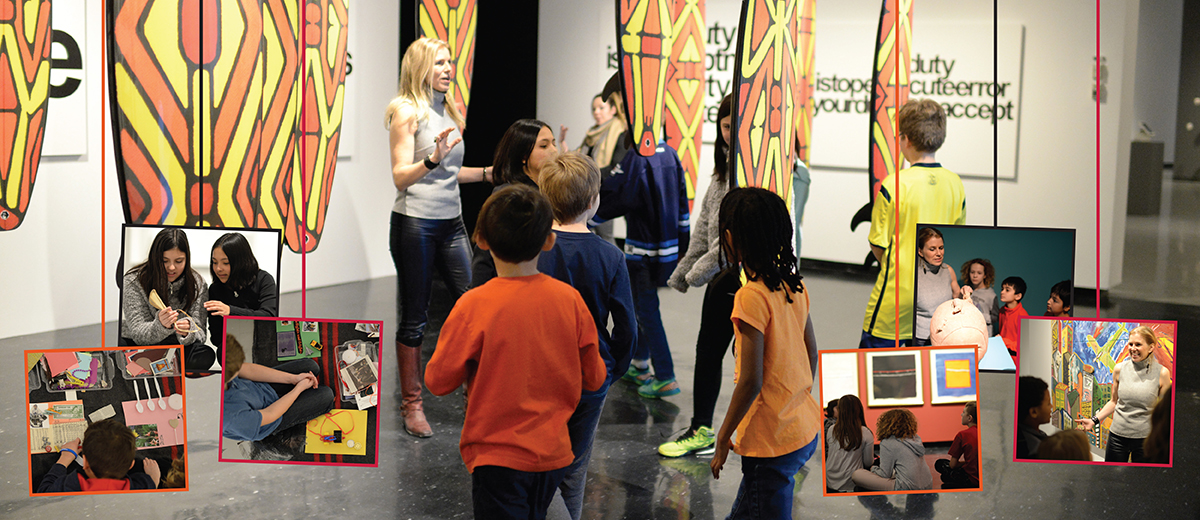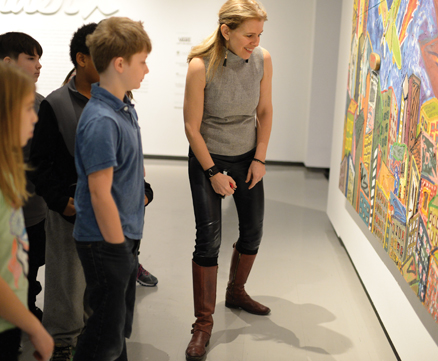
Story By Jennifer McFee
Through a revamped vision, the Winnipeg Art Gallery is embracing Indigenous connections and forging relationships with remote communities.
With the goal of expanding its reach outside city limits, the art gallery is currently piloting an interactive education program to overcome geographical barriers.
The Winnipeg Art Gallery has joined forces with a company called TakingITGlobal, which connects with schools in Northern Canada through its program Connected North. Offered in partnership with the technology firm Cisco, this program uses a two-way video system to reach distant communities.
Winnipeg Art Gallery’s head of education Rachel Baerg is looking forward to the long-distance collaboration.
“TakingITGlobal is a non-profit technology networking group that consists of young millennials that really want to empower youth throughout Canada and throughout the world to make changes,” she said.
“They use technology to connect youth and to embolden them and support them in the things that they want to see happen. Currently, they have over 500,000 connections with youth around the world.”
In particular, TakingITGlobal aims to use technology to unite northern communities with specialists across the globe.
“It really fosters student engagement,” Baerg said. “Knowing that we have wonderful exhibitions and programs here, they wondered if we wanted to do a virtual field trip for some of these schools that are interested.”
Plans are in the works to forge virtual connections with a high school in Arviat, Nunavut, to tour the gallery exhibit called Our Land. Other classes in Brampton and Vancouver are also interested in getting involved.
“We’re going to be giving them a 45-minute virtual tour through this exhibition, which has all kinds of carvings, wall hangings, implements and clothing, including a beautiful loon hat and a caribou parka. It’s a great opportunity for us to expose them to all different mediums and to Inuit art and culture in general, as well as how an art gallery works behind the scenes,” Baerg said. “
“For the kids in Arviat, maybe some of them have never been in an art gallery before. They might be surprised to see that artists from their community actually have work in the art gallery and it looks so amazing in this space.”
After the virtual tour, discussions can continue through a question-and-answer period.
“We give the northern kids the ability to chime in with their stories because this is their artwork,” Baerg said. “We want to facilitate the discussions and use the artwork as a catalyst for learning and for sharing.”

Through these ongoing initiatives, the art gallery can act as a conduit for adding Indigenous perspectives to classroom learning. In Moore’s experience, some teachers have been struggling with how to teach topics that they might not have learned in school themselves, such as those stemming from the Truth and Reconciliation Commission
These virtual tours also act as a lead-up to the launch of the Winnipeg Art Gallery’s new Inuit Art Centre, which is expected to break ground this year and open its doors in 2020.
Once the Inuit Art Centre opens, local students can gather in an on-site classroom and connect virtually with other classes around the province, particularly those in the north. Through technology, the students can engage in discussions and learn from each other — and possibly even enjoy real-time visits from Indigenous artists or elders in northern communities.
“We’re super excited about education in the new Inuit Art Centre because we’re going to have more versatile spaces, beautiful art studios, interactive galleries, maker spaces and global classrooms,” Baerg said.
“We’re going to embrace technology like we never have before, so there’s all kinds of potential for us to do really unique things.”
Once the new centre opens, teachers can look forward to exploring the Winnipeg Art Gallery’s full Inuit art collection of nearly 14,000 pieces. In addition, the Government of Nunavut is providing another 7,500 pieces of fine art and artifacts on a long-term loan.
“There’s always going to be amazing exhibitions, but the kids can see the entirety of our collection when they come in. It’s certainly going to be a lot to explore. The hope is to create engaging experiences when people come to visit the gallery but also to create some really interesting satellite or online opportunities,” Baerg said.
“We’re working with other technology groups to look at things like 360 films or perhaps an online educational game. There could maybe be educational trails with QR codes using Inuit symbols. There are all kinds of possibilities that we’re in the process of exploring.”
Currently, about 25,000 students visit the Winnipeg Art Gallery each year. Once the Inuit Art Centre is built, that number is expected to rise to around 100,000.
In the meantime, the plan is to continue pushing forward with interactive education in an effort to engage with every school division in the province, either virtually or in person.
Through its renewed vision and direction, the Winnipeg Art Gallery is also bolstering its focus on Indigenous programs, tours and workshops available for classes who visit the venue.
Youth art educator Allison Moore has been working on new school programs this year, including many that maintain an Indigenous focus.
Tours for early years students include Art of the First Peoples of Canada and Inuit Art & Life in the North. Middle years students can enjoy tours called Indigenous Art of Canada as well as Living Traditions & Stories in Inuit Art. For senior years students, the art gallery offers tours called Aboriginal History through Art and Inuit Art in the Contemporary World.
“We looked at the social studies curriculum for each level,” Moore said. “We selected some particular outcomes that we want to connect with, and the tour guides are aware of those. As the exhibitions change, we figure out how we can connect the curriculum with the art that is in the gallery.”
Adding to the experience, some classes opt to include a workshop with their tour. Currently, the art gallery offers three workshops that focus on Indigenous artwork.
Through the Inuit Wall Hanging workshop, participants can explore felt and stitched wall hangings before they create their own out of coloured paper.
In the Inuit Print workshop, students create their own Inuit-inspired artwork by carving and printing on Styrofoam.
For the Promise Medals workshop, students learn about treaty medals and then create their own three-dimensional medal out of self-hardening clay.
Through these ongoing initiatives, the art gallery can act as a conduit for adding Indigenous perspectives to classroom learning. In Moore’s experience, some teachers have been struggling with how to teach topics that they might not have learned in school themselves, such as those stemming from the Truth and Reconciliation Commission.
“They were feeling a little bit like they needed support in terms of starting to teach this new material, particularly the calls to action. As a cultural organization, we felt that we could really help teachers to bring their kids in and to support the kind of learning that they’re doing in class as it relates to Indigenous history,” Moore said.
“So we see the WAG as playing an important role, and we work together with the Manitoba Museum as well. We both feel the responsibility to help support teachers as they’re learning these curriculums and starting to put them to action in their own teaching.”
For more information or to book a tour, visit www.wag.ca/bookatour or call 204-789-1290.
— This story was originally printed in the June 2017 issue of The Manitoba Teacher Magazine
